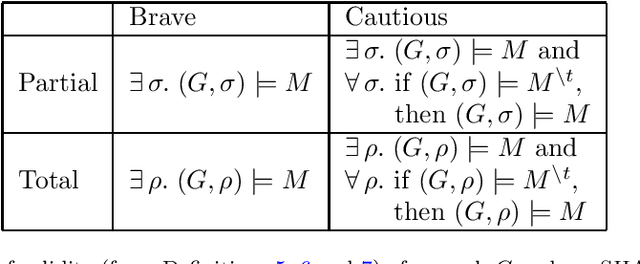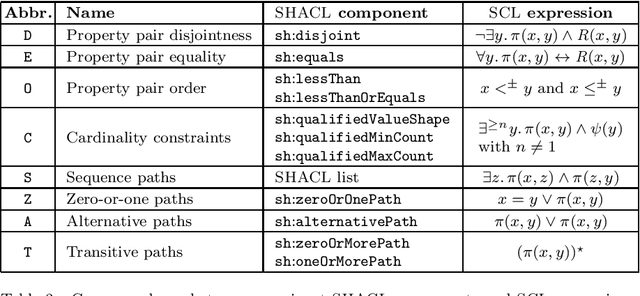George Konstantinidis
A Review of SHACL: From Data Validation to Schema Reasoning for RDF Graphs
Dec 02, 2021



Abstract:We present an introduction and a review of the Shapes Constraint Language (SHACL), the W3C recommendation language for validating RDF data. A SHACL document describes a set of constraints on RDF nodes, and a graph is valid with respect to the document if its nodes satisfy these constraints. We revisit the basic concepts of the language, its constructs and components and their interaction. We review the different formal frameworks used to study this language and the different semantics proposed. We examine a number of related problems, from containment and satisfiability to the interaction of SHACL with inference rules, and exhibit how different modellings of the language are useful for different problems. We also cover practical aspects of SHACL, discussing its implementations and state of adoption, to present a holistic review useful to practitioners and theoreticians alike.
Satisfiability and Containment of Recursive SHACL
Aug 30, 2021



Abstract:The Shapes Constraint Language (SHACL) is the recent W3C recommendation language for validating RDF data, by verifying certain shapes on graphs. Previous work has largely focused on the validation problem and the standard decision problems of satisfiability and containment, crucial for design and optimisation purposes, have only been investigated for simplified versions of SHACL. Moreover, the SHACL specification does not define the semantics of recursively-defined constraints, which led to several alternative recursive semantics being proposed in the literature. The interaction between these different semantics and important decision problems has not been investigated yet. In this article we provide a comprehensive study of the different features of SHACL, by providing a translation to a new first-order language, called SCL, that precisely captures the semantics of SHACL. We also present MSCL, a second-order extension of SCL, which allows us to define, in a single formal logic framework, the main recursive semantics of SHACL. Within this language we also provide an effective treatment of filter constraints which are often neglected in the related literature. Using this logic we provide a detailed map of (un)decidability and complexity results for the satisfiability and containment decision problems for different SHACL fragments. Notably, we prove that both problems are undecidable for the full language, but we present decidable combinations of interesting features, even in the face of recursion.
SHACL Satisfiability and Containment (Extended Paper)
Aug 31, 2020Abstract:The Shapes Constraint Language (SHACL) is a recent W3C recommendation language for validating RDF data. Specifically, SHACL documents are collections of constraints that enforce particular shapes on an RDF graph. Previous work on the topic has provided theoretical and practical results for the validation problem, but did not consider the standard decision problems of satisfiability and containment, which are crucial for verifying the feasibility of the constraints and important for design and optimization purposes. In this paper, we undertake a thorough study of different features of non-recursive SHACL by providing a translation to a new first-order language, called SCL, that precisely captures the semantics of SHACL w.r.t. satisfiability and containment. We study the interaction of SHACL features in this logic and provide the detailed map of decidability and complexity results of the aforementioned decision problems for different SHACL sublanguages. Notably, we prove that both problems are undecidable for the full language, but we present decidable combinations of interesting features.
A Policy Editor for Semantic Sensor Networks
Nov 15, 2019

Abstract:An important use of sensors and actuator networks is to comply with health and safety policies in hazardous environments. In order to deal with increasingly large and dynamic environments, and to quickly react to emergencies, tools are needed to simplify the process of translating high-level policies into executable queries and rules. We present a framework to produce such tools, which uses rules to aggregate low-level sensor data, described using the Semantic Sensor Network Ontology, into more useful and actionable abstractions. Using the schema of the underlying data sources as an input, we automatically generate abstractions which are relevant to the use case at hand. In this demonstration we present a policy editor tool and a simulation on which policies can be tested.
SHACL Constraints with Inference Rules
Nov 01, 2019



Abstract:The Shapes Constraint Language (SHACL) has been recently introduced as a W3C recommendation to define constraints that can be validated against RDF graphs. Interactions of SHACL with other Semantic Web technologies, such as ontologies or reasoners, is a matter of ongoing research. In this paper we study the interaction of a subset of SHACL with inference rules expressed in datalog. On the one hand, SHACL constraints can be used to define a "schema" for graph datasets. On the other hand, inference rules can lead to the discovery of new facts that do not match the original schema. Given a set of SHACL constraints and a set of datalog rules, we present a method to detect which constraints could be violated by the application of the inference rules on some graph instance of the schema, and update the original schema, i.e, the set of SHACL constraints, in order to capture the new facts that can be inferred. We provide theoretical and experimental results of the various components of our approach.
Rule Applicability on RDF Triplestore Schemas
Jul 02, 2019

Abstract:Rule-based systems play a critical role in health and safety, where policies created by experts are usually formalised as rules. When dealing with increasingly large and dynamic sources of data, as in the case of Internet of Things (IoT) applications, it becomes important not only to efficiently apply rules, but also to reason about their applicability on datasets confined by a certain schema. In this paper we define the notion of a triplestore schema which models a set of RDF graphs. Given a set of rules and such a schema as input we propose a method to determine rule applicability and produce output schemas. Output schemas model the graphs that would be obtained by running the rules on the graph models of the input schema. We present two approaches: one based on computing a canonical (critical) instance of the schema, and a novel approach based on query rewriting. We provide theoretical, complexity and evaluation results that show the superior efficiency of our rewriting approach.
The Bag Semantics of Ontology-Based Data Access
May 19, 2017Abstract:Ontology-based data access (OBDA) is a popular approach for integrating and querying multiple data sources by means of a shared ontology. The ontology is linked to the sources using mappings, which assign views over the data to ontology predicates. Motivated by the need for OBDA systems supporting database-style aggregate queries, we propose a bag semantics for OBDA, where duplicate tuples in the views defined by the mappings are retained, as is the case in standard databases. We show that bag semantics makes conjunctive query answering in OBDA coNP-hard in data complexity. To regain tractability, we consider a rather general class of queries and show its rewritability to a generalisation of the relational calculus to bags.
 Add to Chrome
Add to Chrome Add to Firefox
Add to Firefox Add to Edge
Add to Edge